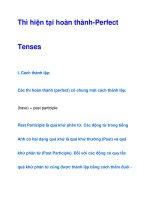Tài liệu Perfect tense (Thì hiện tại hoàn thành) doc
Bạn đang xem bản rút gọn của tài liệu. Xem và tải ngay bản đầy đủ của tài liệu tại đây (100.25 KB, 4 trang )
PRESENT PERFECT TENSE
A/ STRUCTURE:
Subject + have/ has + Ved/pp
B/ USE:
1. We use the Present Perfect Tense to talk about an action which
started in the past and continuous up to now.
Examples
I have been a teacher for more than ten years.
We haven't seen Janine since Friday.
How long have you been at this school?
2. We use the Present Perfect Tense to talk about experiences.
Examples
I have been abroad two times.
Anna has never broken a leg.
Have you ever eaten sushi?
Tip! We often use never and ever with the Present Perfect Tense to talk
about experience.
3. We also use the Present Perfect Tense to talk about a past action that
has the result in the present.
Examples
I have lost my wallet. = I don't have it now.
Jimmy has gone to South America. = He isn't here now.
Have you finished your homework? = Is your homework ready?
4. The Present Perfect Tense is used for giving the news of recent
events or we talk about past event and do not mention exactly when
it happened.
Examples
My brother has bought a new laptop.
There has been a plane crash near London.
5. We often use Present Perfect to say that something has happened
several times up to the present.
Examples
“I have read four books this month” (VS “I read four books last month”).
Present Perfect or Simple Past?
The Present Perfect tells us about the past and the present.
The Past Simple tells us about the past, a time which is finished.
Example:
- We’ve won the Cup! It’s ours at last!
The ABC team have won
the Cup, so it’s theirs now.
- Well, we won the Cup last year.
The ABC team may haven’t won
the Cup this year.
We often give a piece of news in the Present Perfect: We’ve bought a new
car The car is ours now.
We use the Past Simple to give details or to ask for details about things such
as When and Where it happened: We bought a new car last week.
The Present Perfect is often used when giving recent news: Martin has
crashed his car again
This is new information.
The Past Simple is used when giving older information: Martin crashed his
car last year.
o We use the Present Perfect for a state, an action which has gone on up to the
present.
o We use the Simple Past for a state, an action in the past, in a period which is
finished.
Examples
- He has been a teacher for more than ten years
He’s still a
teacher.
- He was a teacher for more than ten years
He is not a teacher
anymore.
Signal words: just, for, since, already, not…yet, ever, never, before, so far,
until now=up to now, lately=recently,…
Examples
- We've already had our breakfast.
- Haven't you got ready yet? Look at the time!
Present Perfect Continuous
A/ STRUCTURE:
Subject + have/ has + been + V-ing
B/USE:
6. Talk about an action which started in the past and continuous up to now, it
will probably continue into the future.
Examples:
We have been waiting here for 20 minutes. (We are waiting now.)
Listen, that burglar alarm has been ringing since 8am this morning.
7. We use the present perfect continuous tense to talk about an action that
started in the past and stopped recently. There is usually a result now.
Examples:
I'm tired because I've been running.
Why is the grass wet? Has it been raining?
You don't understand because you haven't been listening.
For and Since
We use for with a period of time, for example: a few days, half an hour, two years.
We use since with the time when the action started, for example: last year, June 8,
I met you.
Since and for are very often used with the present perfect as this tense enables us
to emphasise the on-going nature of the activity.
Examples
- How long have you been working for that software company? ~ I've been
working for them for two years now.
- I'm out of work. I've been looking for a job since last Christmas, but I can't
seem to find anything.









